Note: This website was automatically translated, so some terms or nuances may not be completely accurate.
Art brands a nation. Report on the quinquennial art festival "documenta"

Higashi Naruki
Hello. I'm Naruki Higashi from Dentsu Inc., in charge of the art-related project "Art Circuit." Art Circuit is a cross-functional organization spanning both inside and outside the company, with members including collectors, researchers, and even artists. Last year, we held a lecture series themed "Creating Work Through Art," attracting 200 participants from both inside and outside the company.

Japan's art market has room to grow significantly. Our mission is to connect diverse people involved in art and create a "circuit." We aim to help elevate the value of art by fostering a cycle where Japanese works receive critical attention both domestically and internationally, increase in value, and find their way into the hands of museums and collectors.
Contact: Bijutsu Circuit &kairo@dentsu.co.jp
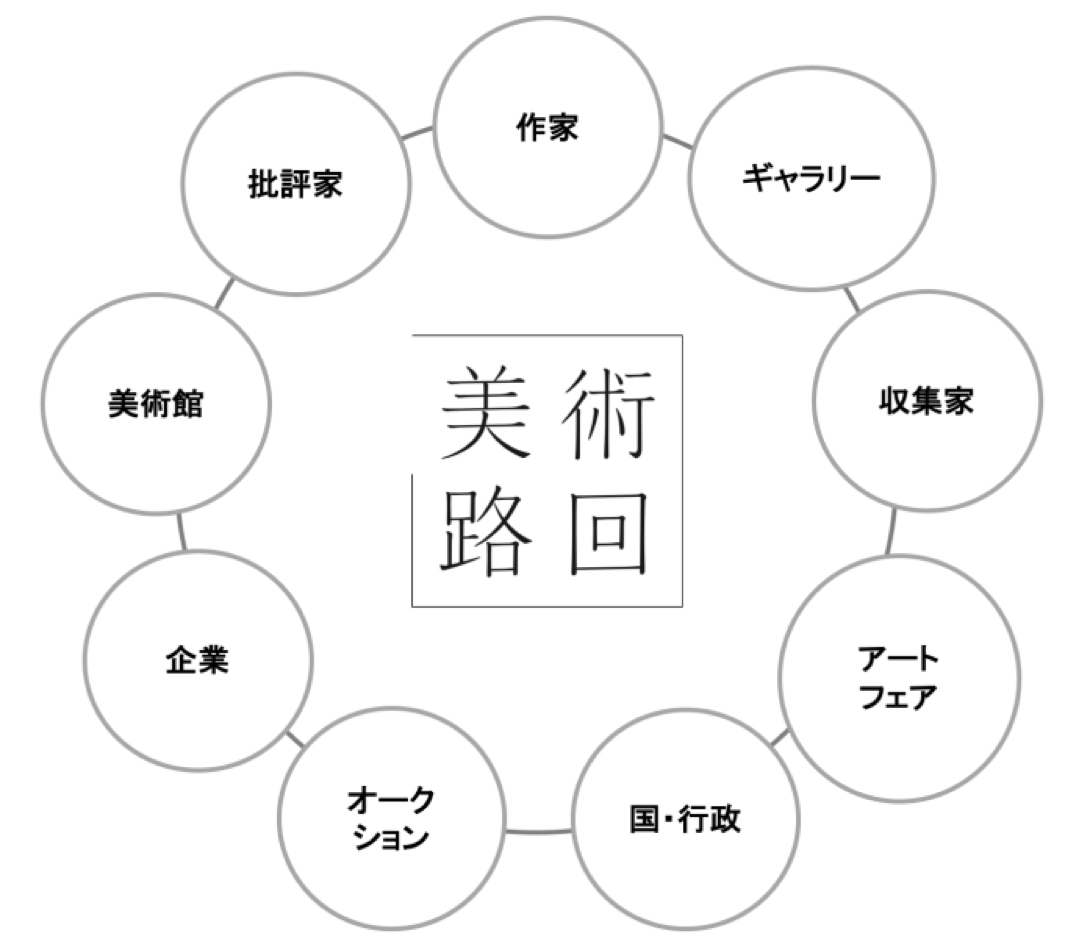
Following our coverage of last year's once-in-a-decade "Münster Sculpture Project, " we now bring you a report on " documenta," hailed as one of the world's most influential art festivals and described as "setting the direction for art exhibitions over the next five years."
Documenta is widely credited with cementing Germany's position as a global leader in contemporary art. But how did this initiative, originating in the single city of Kassel, evolve into an art festival capable of shaping a nation's cultural reputation and influencing art history? And why does it consistently receive substantial support from government and corporate sponsors, despite often exhibiting provocative works that spark intense debate? Through an introduction to this year's exhibition and an interview with Daniel Neugebaur, who oversees Documenta's marketing, we explore the German cultural landscape that enables the exhibition of even politically challenging works.
Promoting Postwar Germany as a "Nation of Culture" to the World
First, let's discuss Documenta's origins.

The venue is Kassel, located in the heart of Germany. Eighty percent of the city was destroyed during World War II, and after the war, it hosted the Flower Festival.
Ten years after the war ended, in 1955. With Germany finally showing signs of economic recovery, voices emerged among the people calling for a reexamination of history and a renewal of dialogue with other nations. Arnold Bode, a native of Kassel with extensive experience organizing exhibitions, responded by launching the first documenta. His vision was to present Germany as a cultural nation through art, a universal language, and to reintegrate Germany into the flow of Western culture.
Reference: Siebenhaar, Klaus (2017). documenta. A BRIEF HISTORY OF AN EXHIBITION AND ITS CONTEXTS. Berlin: B&S SIEBENHAAR VERLAG Berlin/Kassel, 27-28.
To shine a light once more on modern masterpieces, it exhibited works by artists like Picasso and Kandinsky, whose art had been rejected by the Nazis during the war. By re-exhibiting works previously condemned by the state as degenerate art, it conveyed a stance of ensuring the mistakes of war were not forgotten.
From this point onward, Documenta began exhibiting works by artists representative of their era, establishing itself as a leading exhibition of contemporary art. Starting with the 5th edition (1972), it became firmly established as a biennial international exhibition.
Works Imbued with Political Messages
While Documenta is typically held in Kassel, Germany, the 14th edition (2017) took place in two venues: Kassel and Athens, Greece. Approximately 900,000 visitors attended the Kassel exhibition from June 10 to September 17, while the concurrent Athens exhibition, held from April 8 to July 16, drew around 300,000 visitors.
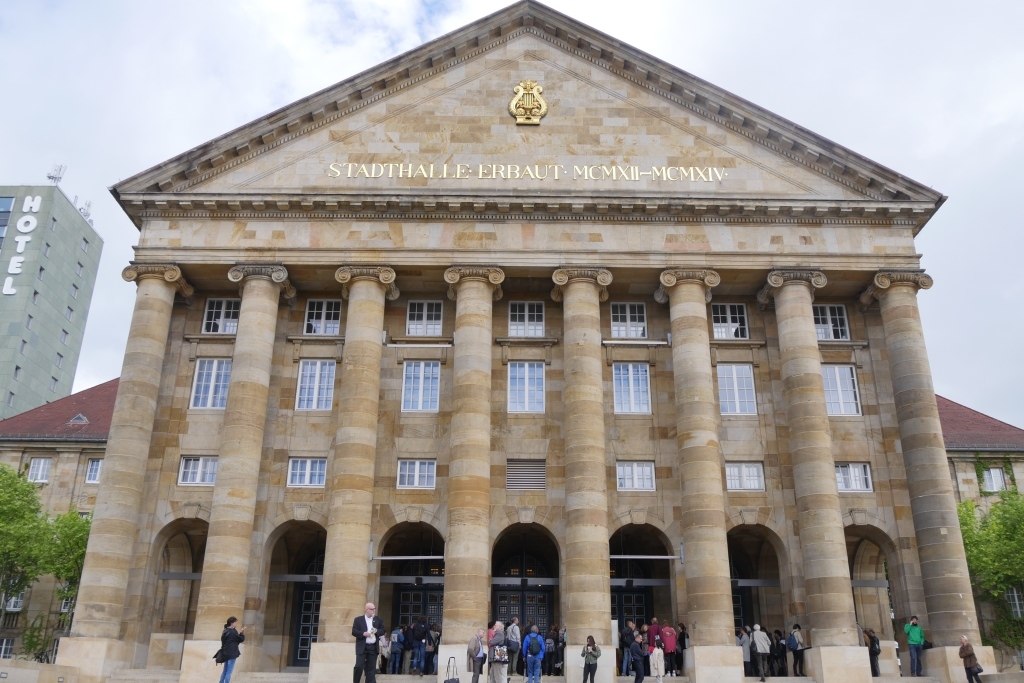

In the left photo, Documenta Artistic Director Adam Szymczyk is on stage. On the right is the press kit. It contained a map, schedules for various performances, a discount coupon for the official book, and an invitation to the reception party. According to the press kit, the main sponsors were Volkswagen and Sparkassen Finanzgruppe (Savings Bank Group).
Exhibitions by approximately 160 artists are spread across 35 venues in Kassel. Travel is primarily on foot or by tram (streetcar), with free shuttle services provided by sponsor Volkswagen to some venues. Seeing all the works requires a full 3 to 4 days.
Now, let's introduce some representative works.
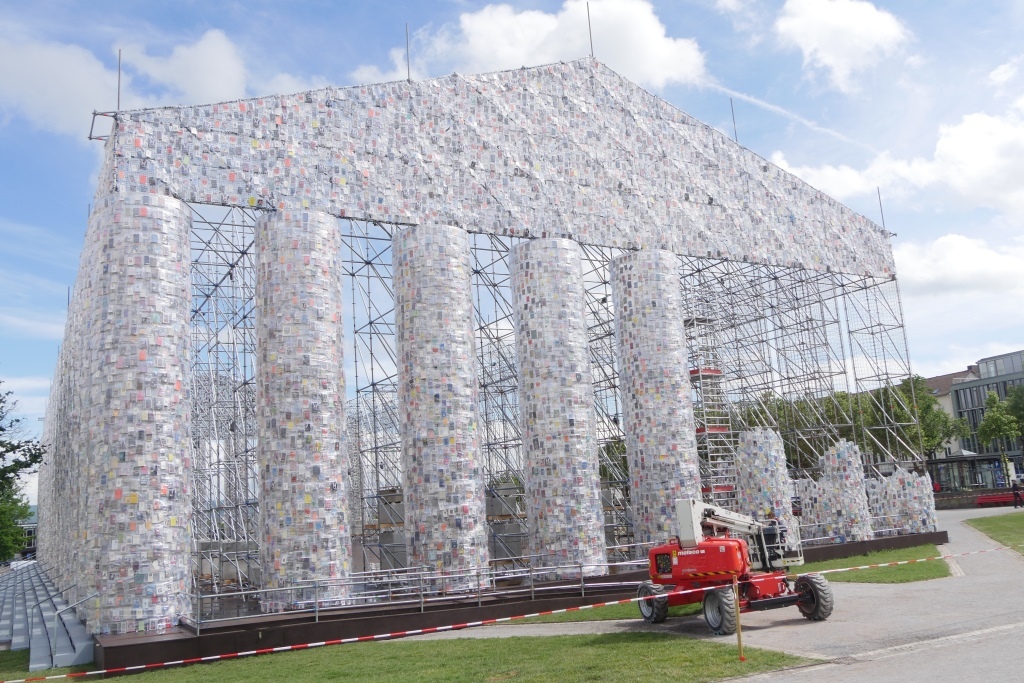
Marta Minuhin's "The Parthenon of Books" (2017) is a temple constructed by stacking approximately 100,000 banned books. It matches the size of the Parthenon on the Acropolis hill in Athens, consciously echoing the Athens venue. The photo shows the structure under construction, taken before the opening.
This work was erected on Friedrichplatz, the square in front of the main venue. This very spot holds the historical memory of books deemed ideologically unsuitable being burned under Nazi Germany. You can see this is an exhibition imbued with political message.
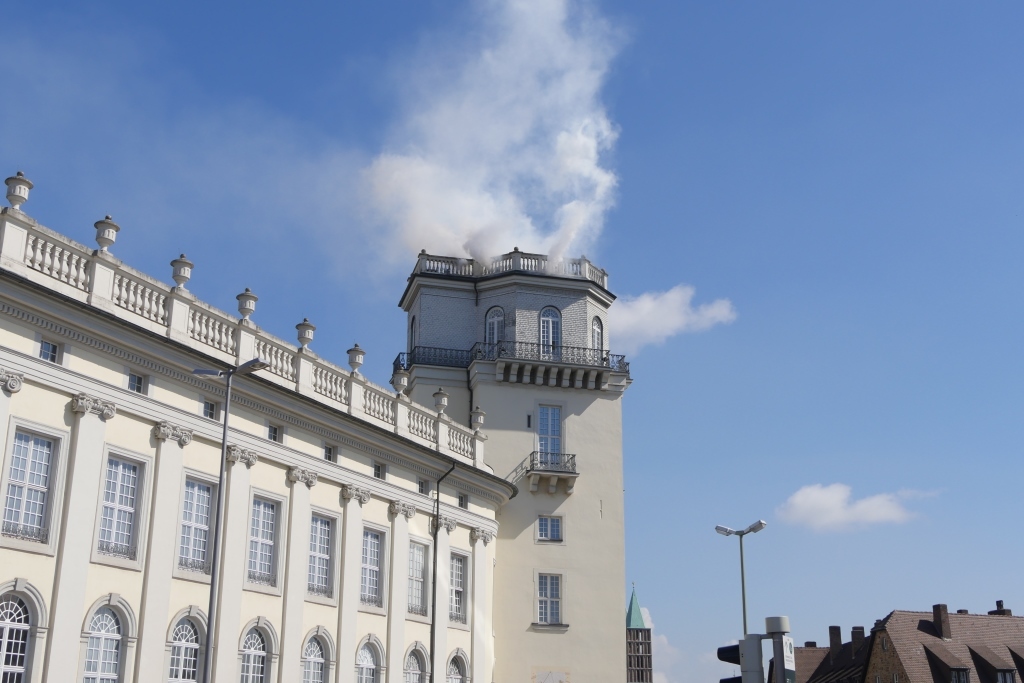
What do you think this is? When I first saw it, I thought, "Oh, smoke is coming out." But it's actually an artwork by Daniel Knoll called "Expiration Movement" (2017). I only learned later that it was an artwork.
This piece also evokes books banned and burned. The library that once stood here was also destroyed by war damage. The billowing smoke resembles factory chimneys and, according to the artist, suggests the art market where money flies around.

This is "Pile o' Sápmi" (2017) by Marit Anne Sara from Norway. Reindeer skulls are suspended in a curtain-like formation. For the Sami, the indigenous people of the Nordic region, reindeer are not merely a food source but a vital part of their existence. However, the Norwegian government enacted laws forcing the Sami to cull their reindeer herds to reduce their numbers. In response, the artist's Sami brother filed a lawsuit against the government. This work highlights the issues surrounding the way of life of minority groups.
Upon closer inspection, each skull bears a hole resembling a bullet wound, telling the story of the brutality of the government's coercion.
Reference: Documenta official website
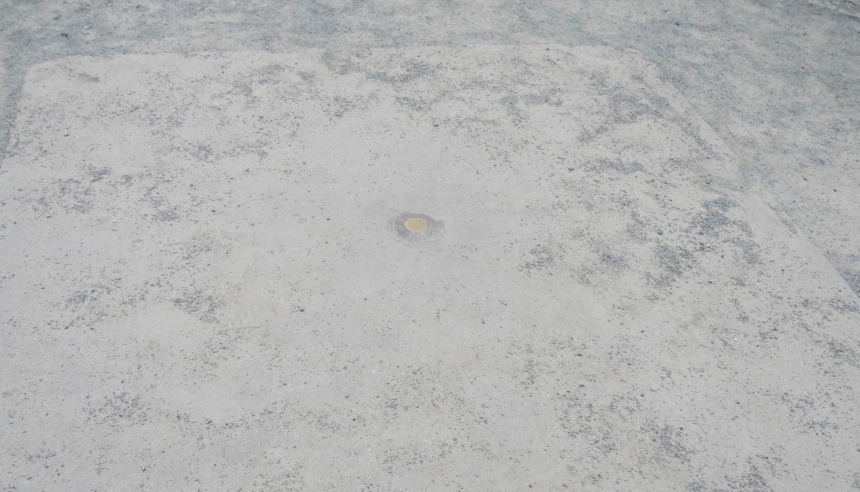
Can you see the golden circle in the center of the photograph? The final work introduced is Walter De Maria's "The Vertical Earth Kilometer" (1977). In fact, a metal rod extends straight down through the ground for one kilometer directly beneath this golden circle. While the work itself is barely visible, viewers imagine the piece buried one kilometer underground, reminding them of the wonder of standing on the earth's surface. This work was exhibited at the 6th Documenta. Kassel still holds works that have made history.
Even if controversy arises, exhibit with courage
Why do people gather from around the world for an art festival in one region? We spoke with Daniel Neugebaur, a member of the Documenta organizing team responsible for communications and sponsorship.
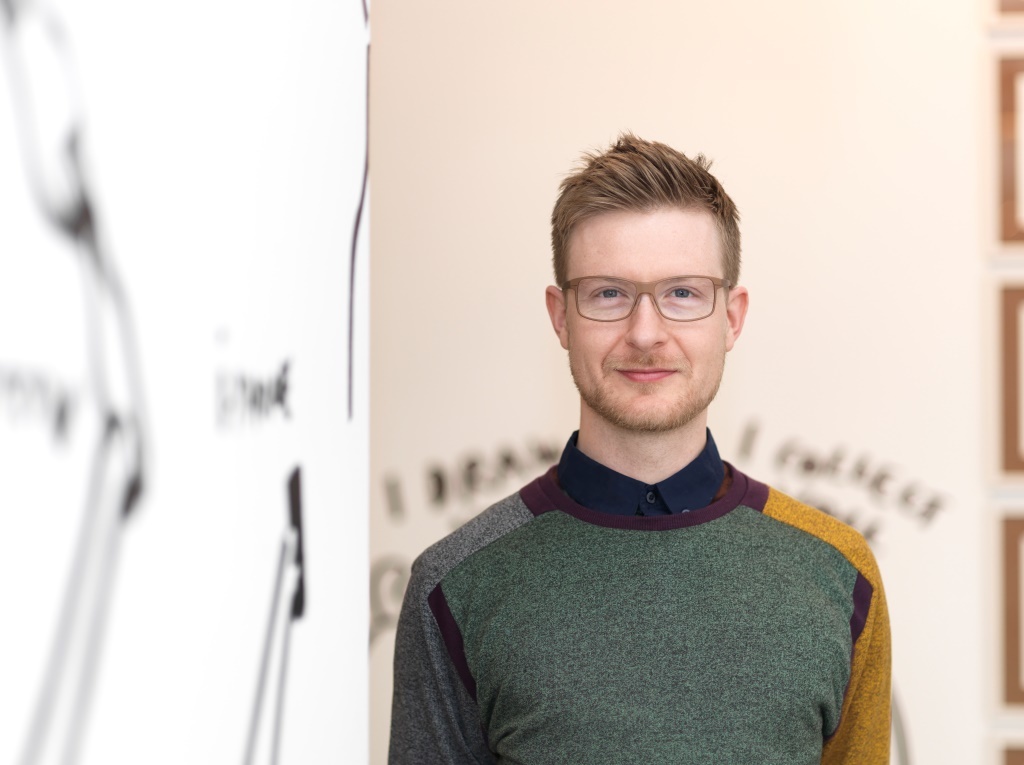
The city of Kassel fully supports Documenta. Why is that?
"Because visitors from around the world generate significant economic impact. Kassel suffered extensive damage during the war precisely because it was a major center for military industry. Conversely, this meant the city lacked much industry after the war. One of Kassel's assets was the Friedrichs Museum, the first private art museum on the European continent."
In the postwar period, as both industry and the city were rebuilding, Kassel focused on contemporary art, relying on its citizens' appreciation for the arts. In fact, this year, approximately 900,000 people visited Kassel during the 100-day exhibition period. If we assume each visitor spent tens of thousands of yen, it's clear a substantial amount of money flows into the city.
But isn't it frightening for the city and sponsors when art touches on political issues?
"If we're afraid, we can't create exhibitions. Because exhibitions should spark debate. Of course, people enjoy seeing beautiful flowers or paintings of sunsets, but that won't change the world. To move things forward, generating discussion is crucial. For that, friction is necessary. We must have the courage to handle that friction.
I believe art is a tool to tell people what's happening in the world. It points to the crises unfolding now and directs everyone's attention. Through politically charged works that spark debate, I want to cultivate a flexible mindset in viewers over the long term."
The art envisioned by Documenta not only stimulates the senses but carries a powerful message strong enough to spark debate, transcending regions to reach the world. In Germany, there exists an environment where cities, major manufacturers, and banks support this vision without fear. That is precisely why exhibitions capable of influencing art history and drawing visitors from around the world can be realized.
By the way, the logo for this year's Documenta was an owl. What was the intention behind that?
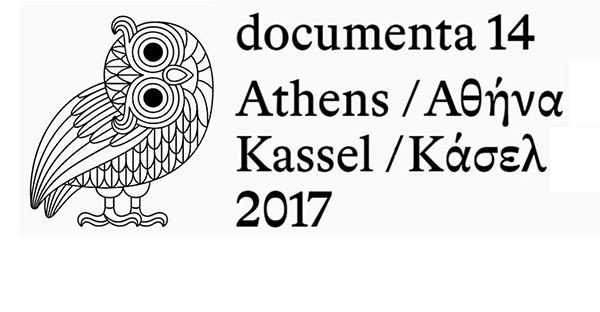
"First, the owl is a symbol of wisdom and also represents Athens, where Documenta was held concurrently this time. Mythology says it protected the city, and indeed, many owls lived in ancient Athens.
Second, owls can tilt their heads to view things from various angles. This resonates with our desire to 'offer new perspectives.'"
The theme this time was "Learning from Athens." Why did you decide to hold the exhibition, traditionally held only in Kassel, across national borders in Athens as well?
"Artworks cannot exist independently of their surrounding context. The same piece takes on entirely different meanings when exhibited in Kassel versus Athens. That is what Documenta continues to convey: shifting perspectives, changing positions. By flapping our wings and tilting our heads like owls, we might approach a truer picture of things."
This conveys an attitude of reexamining the history of art, woven in specific Western European countries, from the different perspective of Athens. For example, both Germany and Greece face the issue of accepting refugees. How would the perception change if works addressing ethnic issues were exhibited in each of these places? It poses such questions to us.
Understanding art and the courage to engage in debate
Documenta transcends being merely a regional tourism initiative; it poses questions to the world. Behind it lay the grand ambition: "Utilize art, the universal language, to position post-war Germany as a cultural nation." Consequently, exhibitions centered on contemporary art emerged, drawing together artists from around the globe.
But is any art acceptable? According to Daniel, what matters are not merely beautiful paintings, but works that spark debate. That is precisely why internationally significant pieces confronting global issues gather here.
What we can learn from Documenta is the understanding and courage of its operational team, the city, sponsors, and viewers. It is precisely because discussions arise, including opposing views, that artists and curators can pursue higher-level works and exhibitions.
What underpins exhibitions that influence the global art world is a culture receptive to art.
Was this article helpful?
Newsletter registration is here
We select and publish important news every day
For inquiries about this article
Back Numbers
Author

Higashi Naruki
Recipient of the Good Design Award, Spikes Asia Grand Prix, AD STARS Grand Prix, and the Grand Prix for the Transportation Advertising Grand Prix's Most Outstanding Category. His book, "Art in Business" (Yuhikaku), systematizes practical methods for incorporating art into business. Privately, he conducts interviews domestically and internationally, contributing to media outlets and sharing content on his YouTube channel. He is developing a real estate information media platform in Dubai, a city experiencing remarkable economic growth. He left Dentsu Inc. in February 2023.
